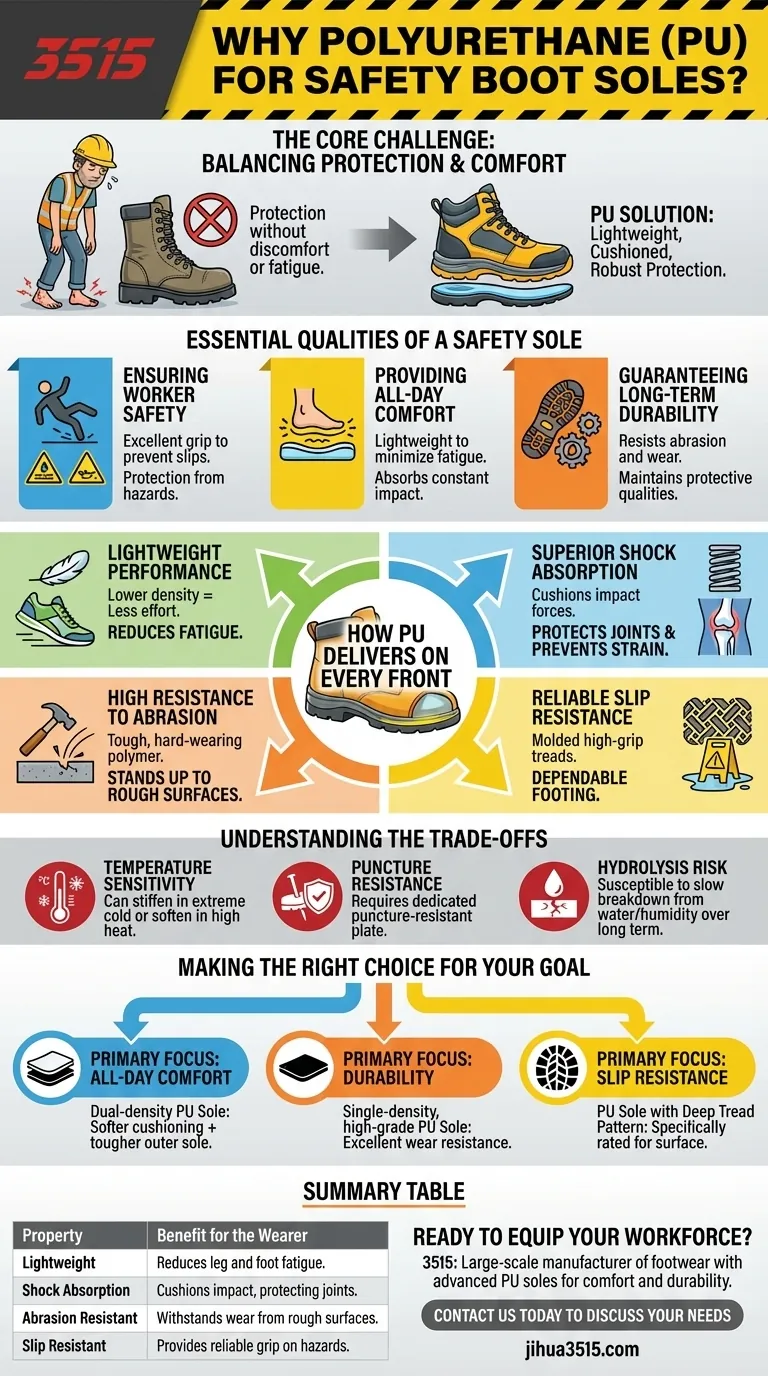At its core, polyurethane (PU) is used in safety boot soles because it delivers an exceptional balance of safety, comfort, and durability. This synthetic material is uniquely capable of being lightweight to reduce fatigue while also providing robust shock absorption, slip resistance, and the toughness needed to withstand abrasive work environments.
The central challenge in safety footwear is protecting the wearer without causing discomfort or fatigue over a long workday. Polyurethane solves this by offering critical protective properties in a lightweight, cushioned material, making it a superior choice for modern safety soles.

The Essential Qualities of a Safety Sole
Before examining polyurethane specifically, it's crucial to understand what a safety boot sole is fundamentally designed to do. Its performance is judged on three primary functions.
Ensuring Worker Safety
The non-negotiable priority is protection. A sole must provide excellent grip to prevent slips on hazardous surfaces, including those contaminated with water, oil, or chemicals.
Providing All-Day Comfort
Workers are on their feet for hours. The sole material must be lightweight to minimize fatigue and must absorb the shock of constant impact with hard surfaces to protect joints and prevent strain.
Guaranteeing Long-Term Durability
Safety boots are an investment and are subjected to harsh conditions. The sole must resist abrasion and wear to maintain its protective qualities and tread pattern over time.
How Polyurethane Delivers on Every Front
Polyurethane's molecular structure allows it to be engineered to meet the competing demands of safety, comfort, and durability more effectively than many traditional materials.
Lightweight Performance to Reduce Fatigue
PU has a lower density than materials like solid rubber. This significant weight reduction means less effort is required for every step, directly translating to reduced worker fatigue over a full shift.
Superior Shock Absorption
The material acts as an excellent cushion, absorbing impact forces that would otherwise travel up the legs and spine. This property is crucial for preventing chronic pain and is particularly beneficial for workers with conditions like plantar fasciitis.
High Resistance to Abrasion
PU is a tough, hard-wearing polymer. It stands up well to contact with rough surfaces like concrete and gravel, ensuring the sole's tread and structure remain effective for longer.
Reliable Slip Resistance
PU soles can be molded with complex, high-grip tread patterns. The material itself offers good slip resistance, making it a dependable choice for maintaining footing in demanding environments.
Understanding the Trade-offs
While polyurethane is an outstanding all-around material, no single solution is perfect for every possible scenario. Understanding its limitations is key to making an informed choice.
Temperature Sensitivity
Compared to specialized rubber compounds, standard polyurethane can become stiff in extreme cold or soften in very high-heat environments. For work like asphalt paving or arctic conditions, a different sole material may be specified.
Puncture Resistance
While the sole is durable, its primary defense against punctures (like stepping on a nail) comes from a dedicated puncture-resistant plate embedded within the sole, not from the PU material alone.
Hydrolysis Risk
Like many advanced polymers, PU can be susceptible to hydrolysis—a slow breakdown from long-term exposure to water and humidity, especially during storage. However, modern formulations have drastically improved this resistance for a long service life.
Making the Right Choice for Your Goal
Your specific work environment and physical needs should dictate your final choice.
- If your primary focus is all-day comfort and preventing fatigue: A dual-density PU sole, which combines a softer cushioning midsole with a tougher outer sole, is an ideal choice.
- If your primary focus is durability on abrasive surfaces: A single-density, high-grade PU sole provides excellent wear resistance for environments like construction sites and workshops.
- If your primary focus is slip resistance: Look for a PU sole with a well-designed, deep tread pattern specifically rated for the surface conditions you encounter most often.
Ultimately, choosing a boot with a polyurethane sole is an investment in both your immediate safety and your long-term physical well-being.
Summary Table:
| Property | Benefit for the Wearer |
|---|---|
| Lightweight | Reduces leg and foot fatigue during long shifts. |
| Shock Absorption | Cushions impact on hard surfaces, protecting joints. |
| Abrasion Resistant | Withstands wear from rough surfaces like concrete. |
| Slip Resistant | Provides reliable grip on various hazardous surfaces. |
Ready to equip your workforce with high-performance safety boots?
As a large-scale manufacturer, 3515 produces a comprehensive range of footwear for distributors, brand owners, and bulk clients. Our production capabilities encompass all types of safety shoes and boots with advanced polyurethane soles designed for maximum comfort and durability.
Contact us today to discuss your safety footwear needs and discover how we can deliver quality and value to your business.
Visual Guide

Related Products
- Safety Footwear Wholesale Manufacturer for Custom OEM/ODM Production
- Premium Flame-Retardant Waterproof Safety Boots and Shoes
- Wholesale Safety Footwear Manufacturer for Bulk & Custom OEM Orders
- Wholesale Customizable Safety Boots Durable & Protective Footwear Manufacturing
- Premium Wholesale Wheat Nubuck Safety Boot with Rapid Lacing System
People Also Ask
- Do snake bite boots work? Your Ultimate Guide to Effective Snake Bite Protection
- What do heavy duty boots do? Protect Your Feet in Demanding Work Environments
- Is it normal to wear shoes in the house? A Guide to Hygiene, Comfort & Culture
- What are the cultural perspectives on wearing shoes in the house? A Guide to Home Etiquette & Hygiene
- How do safety shoes contribute to cost savings for companies? A Strategic Investment in Risk and Cost Management



















